Abstract
A new mineral, hanauerite, ideally AgHgSI, was found in the oxidation zone of Ag- and Hg-bearing ores at two old, abandoned mines in Rhineland-Palatinate, Germany. In a holotype specimen originating from the Schöne Aussicht Mine, Dernbach, Westerwald, it is associated with plumbogummite–hinsdalite series of minerals and goethite. In cotype from the Friedrichssegen Mine, Bad Ems, it is associated with perroudite, goethite, and quartz. At both localities, hanauerite occurs as a prismatic crystal up to 0.15 mm long and up to 0.02 mm thick. The mineral is yellow, transparent, with an adamantine lustre. It is brittle, and cleavage was not observed. The calculated density values are 6.671 and 6.575 g cm−3 for holotype and cotype, respectively. The empirical formulae calculated (from electron microprobe data) based on the sum of all atoms = 4 apfu are Ag0.95Hg1.00S1.01(I0.83Br0.19Cl0.03)Σ1.05 for holotype and Ag0.97Hg0.97S1.05(I0.76Br0.25)Σ1.01 for cotype. Hanauerite is orthorhombic, space group Pmma; the unit cell parameters (from single-crystal X-ray diffraction data; holotype/cotype) are: a = 9.932(2)/9.9256(8), b = 4.6219(19)/4.6209(2), c = 9.891(4)/9.9006(4) Å, V = 454.0(3)/454.19(5) Å3, and Z = 4. The crystal structure was studied on single crystals extracted from both holotype and cotype specimens; R1 = 0.0416 (holotype) and =0.0544 (cotype). In hanauerite, Hg2+ cations centre strongly distorted octahedra with two short Hg–S bonds (Hg and S atoms build “crankshaft-type” chains) and four strongly elongated Hg–I bonds. The Hg-centred octahedra are connected via common edges and faces to form corrugated layers; Ag+ cations are located between these layers. Hanauerite is named in honour of the German mineral collector Dr. Alfred Hanauer (1912–1988). The common crystal chemical features of mercury sulphohalide minerals are discussed.
1. Introduction
Natural mercury sulphohalides compose a specific—in terms of both geochemistry and crystal chemistry—family of minerals. They form in the oxidation zone of ore deposits containing primary Hg-bearing minerals, the most commonly found cinnabar- or/and Hg-enriched fahlore. Besides mercury, these minerals can effectively concentrate such scattered-in-nature elements as bromine and iodine. This family contains ten mineral species and can be subdivided to two sub-families. One of them consists of six minerals with the general formula Hg3S2Hal2 (Hal = halogen: Cl, Br, I), namely three polymorphs of Hg3S2Cl2 (corderoite [], lavrentievite [,], and kenhsuite []); dimorphous arzakite [,] and grechishchevite [,,], with the ideal end-member formula Hg3S2Br2; and radtkeite Hg3S2ICl [,,]. The second sub-family contains four sulphohalide minerals with both Hg and Ag as metal cations: dimorphs of AgHgSCl (capgaronnite [] and iltisite []); perroudite, Ag4Hg5S5(I,Br)2Cl2 [,,]; and a recently discovered hanauerite, AgHgSI, first described in the present paper. Hanauerite is related to capgaronnite and iltisite in stoichiometry, their chemical analogue being species-defining I instead of Cl; however, these three Ag–Hg sulphohalides strongly differ from each other in symmetry, unit cell dimensions, and powder X-ray diffraction patterns that reflect the structure differences.
The type specimens of hanauerite were collected from two old, abandoned mines located in Rhineland-Palatinate, Germany. The holotype specimen, for which electron microprobe analyses (EMPA), optical data, single-crystal and powder X-ray diffraction (XRD) data were obtained and crystal structure was determined, originates from the Schöne Aussicht Mine, Dernbach, Neuwied, Wied Iron Spar District, Westerwald. The locality of the cotype specimen, for which EMPA and single-crystal XRD data were obtained and crystal structure was determined, is the Friedrichssegen Mine, Frücht, Bad Ems District, Lahn valley.
The new mineral is named in honour of the prominent German mineral collector Dr. Alfred Hanauer (1912–1988). He was a pioneer in the collecting of micromounts in Germany and Central Europe in the early 1960s. Dr. Hanauer collected at the Schöne Aussicht Mine the specimens in which the mineral described here was first found.
Both the new mineral and its name have been approved by the IMA Commission on New Minerals, Nomenclature and Classification (IMA2018–045) []. The type specimens of hanauerite are deposited in the systematic collection of the Fersman Mineralogical Museum of the Russian Academy of Sciences, Moscow, with the catalogue numbers 96264 (Schöne Aussicht Mine) and 96265 (Friedrichssegen Mine).
2. Materials and Methods
2.1. Occurrence, General Appearance, and Physical Properties
Hanauerite is a secondary, supergene mineral formed in the oxidation zone of the complex sulphide ores containing primary silver and mercury sulphide mineralization. At both localities, the new mineral occurs as isolated prismatic crystals, elongated along [010], up to 0.15 mm long and up to 0.02 mm thick in cavities of the oxidized ores. The crystal faces belonging to the {h0l} zone are major and the pinacoid {010} is the major form on terminations. At the Schöne Aussicht Mine, hanauerite is associated with plumbogummite–hinsdalite series minerals in cavities of goethite (limonite) aggregates (Figure 1 and Figure 2). At the Friedrichssegen Mine, hanauerite occurs in association with perroudite, goethite, and quartz.
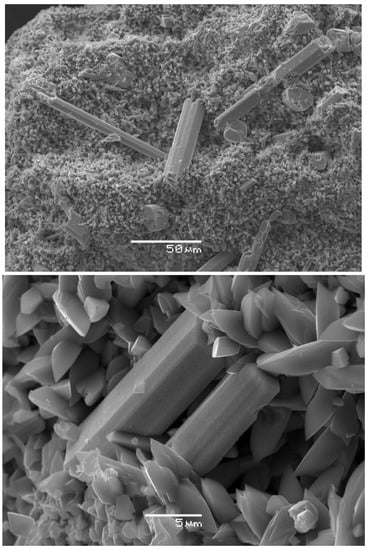
Figure 1.
Prismatic crystals of hanauerite on crusts consisting of sharp rhombohedral plumbogummite crystals. Schöne Aussicht Mine. SEM (SE) images.
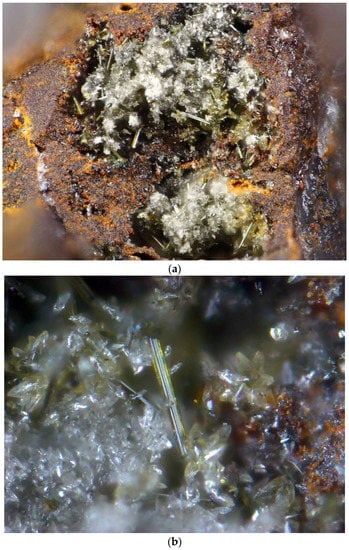
Figure 2.
Yellow prismatic crystals of hanauerite on goethite and aggregates of greenish-yellow rhombohedral plumbogummite crystals. Schöne Aussicht Mine. FOV width: (a)—1.2 mm, (b)—0.35 mm.
The general mineralogical data for the Schöne Aussicht Mine and the Friedrichssegen Mine are reported in [] and [], respectively.
Fresh hanauerite from both localities is yellow; however, like some other silver or mercury halides, it is photosensitive and darkens after exposure to strong light (especially under sunlight), becoming almost black. Hanauerite has an adamantine lustre; fresh crystals are transparent, whereas altered under light crystals are semi-transparent to almost opaque. The mineral is brittle, cleavage or parting was not observed, the fracture is uneven. The density values calculated using the empirical formulae are 6.671 and 6.575 g cm−3 for holotype and cotype, respectively. The difference is caused by different I:Br ratios (see below).
2.2. Methods
Optical studies. The reflectance values for hanauerite were measured by means of the MSF-21 microspectrophotometer (LOMO, St. Petersburg, Russia) using the SiC standard (Zeiss, No. 545).
EMPA. For the determination of chemical composition, hanauerite crystals were embedded into epoxy resin, polished and coated with carbon film. Electron microprobe data were obtained by means of a JEOL Superprobe JCXA-733 instrument. Quantitative analyses were performed in wavelength-dispersive mode under accelerating voltage of 20 kV, beam current 10 nA and beam diameter 5 μm. The following standards were used: Ag2Te (Ag), HgTe (Hg), ZnS (S), atacamite (Cl), TlBr (Br), and CuI (I). The contents of other elements with atomic numbers higher than carbon were below detection limits.
Powder XRD data were obtained using a Rigaku RAXIS Rapid II diffractometer (curved image plate, Debye-Scherrer geometry, r = 127.4 mm, CoKα, rotating anode with microfocus optics, 40 kV, 15 mA, exposure 15 min). Data conversion was performed by means of osc2xrd programme [].
Single-crystal XRD studies were carried out using a Bruker Kappa APEX DUO diffractometer for the holotype specimen and using an Xcalibur S diffractometer for the cotype specimen of hanauerite. Both diffractometers are equipped with CCD detectors, and MoKα radiation was used in both cases. The crystal structures were solved via direct methods. Data collection and structure refinement details are summarized and discussed below, in Section 3.3.
Attempts to measure the micro-indentation hardness value were unsuccessful because hanauerite crystals are tiny and brittle (and not embedded in a rock matrix) that causes the cracking during the indentation of the Vickers diamond pyramid. Density could not be measured because crystals are too small for volumetric methods and because of the lack of heavy liquids of necessary density.
3. Results
3.1. Optical Data
Under the microscope in reflected light, the holotype hanauerite is grey, and pleochroism was not observed. Bi-reflectance is very weak, ΔR = 1.1% (589 nm). Anisotropism is weak. Internal reflections were not observed. The reflectance values are given in Table 1.

Table 1.
The reflectance data of hanauerite from the Schöne Aussicht Mine.
3.2. Chemical Composition
The chemical composition of hanauerite in wt.% is given in Table 2.

Table 2.
Chemical composition of hanauerite.
The empirical formulae calculated on the sum of all atoms = 4 apfu are:
- holotype (Schöne Aussicht Mine): Ag0.95Hg1.00S1.01(I0.83Br0.19Cl0.03)Σ1.05;
- cotype (Friedrichssegen Mine): Ag0.97Hg0.97S1.05(I0.76Br0.25)Σ1.01.
The simplified formula of hanauerite can be written as AgHgS(I,Br). The idealized, end-member formula AgHgSI requires Ag 23.08, Hg 42.91, S 6.86, I 27.15; total 100 wt%.
3.3. X-ray Crystallography and Crystal Structure Determination
Powder XRD data of the holotype hanauerite are given in Table 3. The orthorhombic unit cell parameters calculated from the powder data are: a = 9.931(2), b = 4.622(1), c = 9.909(3) Å, and V = 454.8(3) Å3. The calculations of intensities (Icalc in Table 3) were performed using a standard STOE WinXPOW programme.

Table 3.
Powder X-ray diffraction data (d in Å) of hanauerite from the Schöne Aussicht Mine.
The crystal structure was studied on single crystals for both holotype and cotype specimens of hanauerite. The structures were solved in the frame of the orthorhombic space group Pmma via direct methods and refined with the use of SHELX software package [] and to R = 0.0416 on the basis of 607 independent reflections with I > 2σ(I) (holotype) and to R = 0.0544 on the basis of 635 independent reflections with I > 2σ(I) (cotype). Crystal data and details on data collection and structure refinement are given in Table 4, coordinates and equivalent thermal displacement parameters of atoms in Table 5, and selected interatomic distances in Table 6. Crystallographic information files (CIFs) are available as Supplementary Materials.

Table 4.
Crystal data, data collection information, and structure refinement details of hanauerite.

Table 5.
Coordinates and equivalent displacement parameters (Ueq, in Å2) of atoms, site multiplicities (Q), and site occupancy factors (s.o.f.) of hanauerite. Data for the sample from the Friedrichssegen Mine are given in the first line of each row and data for the sample from the Schöne Aussicht Mine in the second line of each row.

Table 6.
Selected interatomic distances (Å) in the structure of hanauerite.
4. Discussion
4.1. Crystal Structure of Hanauerite
The crystal structure of hanauerite (Figure 3) is very close to those known for its synthetic analogue AgHgSI and isostructural compounds CuHgSeBr and AgHgSBr [], as well as HT phases CuHgSCl [] and CuHgSBr []. These synthetic compounds crystallize in the same orthorhombic space group Pmma and are close to hanauerite in unit cell dimensions. Two crystallographically non-equivalent Hg sites are present in the structure of hanauerite (as well as in the abovementioned synthetic compounds) and each Hg2+ cation forms covalent bonds with two sulphur atoms. The parameters of these bonds are as follows: distances 2.366(5) Å for both Hg sites and S–Hg–S angles 171.2° for Hg(1) and 180.0° for Hg(2) (cotype) and Hg(1)–S 2.372(4) Å and Hg(2)–S 2.363(4) Å and S–Hg–S angles 171.1° for Hg(1) and 180.0° for Hg(2) (holotype). Hg and S atoms form “crankshaft-type” chains along the a axis (Figure 4). The coordination environment of Hg atoms is complemented by elongated Hg–I bonds (Table 6). Thus, distorted Hg-centred octahedra are formed (Figure 5). Both I(1) and I(2) sites are iodine-dominant; the refined I:Br ratios are I0.54Br0.46 for the I(1) site and I0.97Br0.03 for the I(2) site (cotype) and I0.57Br0.43 for the I(1) site and I0.94Br0.06 for the I(2) site (holotype; minor Cl impurity was ignored during the refinement), both resulting in the total I:Br ratio of 3:1 that is in good agreement with electron microprobe data (Table 2). Hg(2)-centred octahedra share I(1)–I(1) edges to form the (001) layers, while Hg(1)-centred octahedra share I(1)–I(2) common edges to form the chains running along [010]. The chains are connected with the corrugated octahedral layers via common faces of octahedra from both sides of each layer (Figure 6). Ag+ cations are located between the octahedral layers in hanauerite. Unlike synthetic compounds AgHgSI and AgHgSBr [], the Ag site in both structurally studied samples of hanauerite is split into two subsites labelled as Ag’ and Ag” (Table 5). The Ag’–Ag” distance is 0.52 Å in the cotype and 0.70 Å in the holotype sample. Their occupancy factors are approximately equal (the refinement presented s.o.f. values of 0.49 for both sites; thus, they were fixed at 0.5 for each) in cotype, while in holotype, the Ag’ site is 74% occupied and Ag” is 26% occupied (Table 5). The location of the Ag’ site in hanauerite is very close to that of the non-split Ag site in synthetic AgHgSI and AgHgSBr. In all these sulphohalides, this position is coordinated by two S atoms and two halogen atoms, thus centring the distorted tetrahedron. The Ag”-centred polyhedron in hanauerite has two short distances Ag”–S, one longer Ag”–I distance, and two strongly elongated Ag”–I distances (Table 6). Coordination environments of Ag sites in hanauerite are shown in Figure 7.
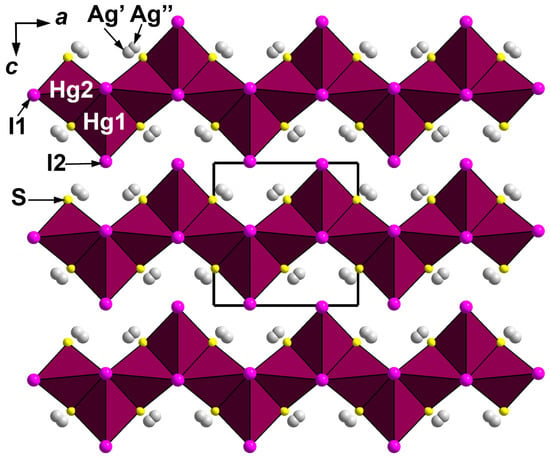
Figure 3.
The crystal structure of hanauerite. The unit cell is outlined.
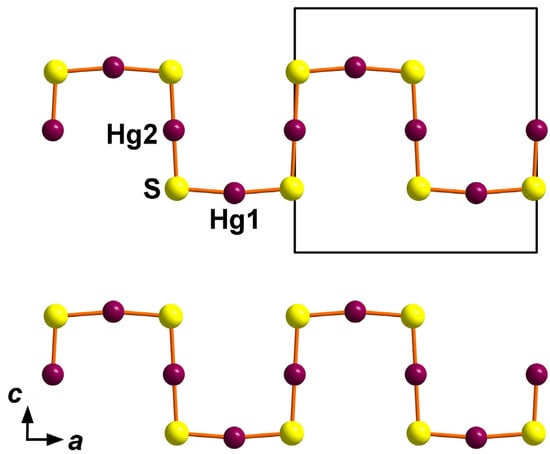
Figure 4.
“Crankshaft-type” Hg–S chains in the structure of hanauerite. The unit cell is outlined.
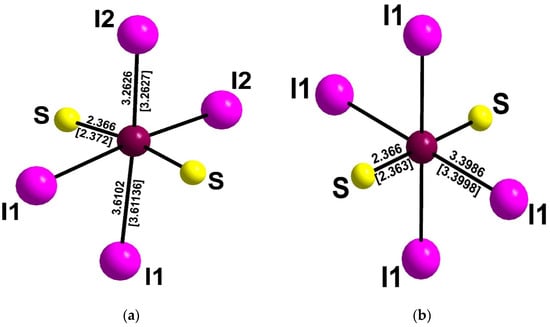
Figure 5.
Coordination environments of Hg(1) (a) and Hg(2) (b) sites in the structure of hanauerite. The distances (in Å) for the holotype sample are given in square brackets and for the cotype sample without brackets.
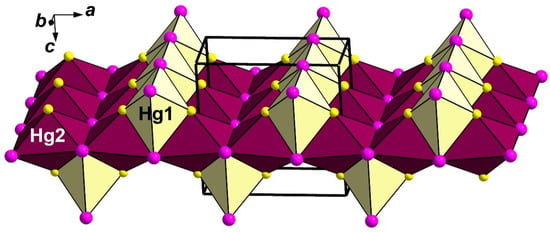
Figure 6.
Octahedral layer built by edge-sharing Hg(2)-octahedra (central part) and chains of Hg(1) octahedra in the structure of hanauerite (for better clarity Hg(1)- and Hg(2)-centred octahedra are illustrated in different colours).
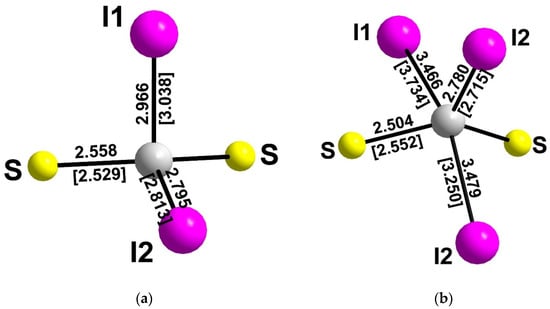
Figure 7.
Coordination environments of Ag’ (a) and Ag” (b) sites in the structure of hanauerite. The distances (in Å) for the holotype specimen are given in square brackets and for the cotype specimen without brackets.
4.2. Common Crystal Chemical Features of Natural Mercury Sulphohalides
In minerals, the octahedral coordination of Hg2+ by sulphur and halogen atoms was reported for capgaronnite [], perroudite [], and the synthetic analogues of corderoite [] and radtkeite [,]. Distorted Hg2+-centred octahedra with two short Hg–S bonds and four elongated Hg–Hal (Hal = Cl, Br, I) were found in the synthetic analogue of grechishchevite [,]. Pervukhina et al. [,] reported a distorted octahedral coordination of Hg atoms in structures of two polymorphic modifications of Hg3S2Cl2–xBrx(x ≈ 0.5) obtained during the attempts to synthesize an analogue of lavrentievite and in two polymorphic modifications of Hg3S2Br2–xClx(x ≈ 0.5) obtained during the attempts to synthesize an analogue of arzakite. In the structure of capgaronnite, HgS2(Cl,Br)4 octahedra form (010) straight layers connected by the pairs of Ag-centred tetrahedra, whereas in perroudite, face-sharing Hg2+ octahedra form triple chains that are further linked by double chains of Hg-centred octahedra to the framework. In both hanauerite and capgaronnite, Hg–S chains are planar but essentially different in topology: the zigzag chain is reported for capgaronnite, and the “crankshaft-type” chain for hanauerite and structurally close and related synthetic compounds. At the same time, in perroudite, these chains are helical as well as cinnabar in shape. Structural relationships of perroudite with capgaronnite, corderoite, cinnabar, and synthetic HgCuSCl, β-Hg3S2Br2, and Hg3S2I3 are discussed in [] and references therein.
5. Conclusions
This paper is devoted to the new mineral hanauerite, ideally AgHgSI, the first natural mercury-bearing sulphohalide in which iodine is the only species-defining halogen. It is an analogue in the formulae for capgaronnite and iltisite, both ideally AgHgSCl; however, they are significantly different in terms of structure and, in general, hanauerite has no structural analogues among minerals.
Hanauerite possesses the same main crystal chemical features as typical for mercury sulphohalides. The cations Hg2+ occupy strongly distorted octahedra with two short Hg–S bonds (Hg and S atoms build “crankshaft-type” chains) and four strongly elongated Hg–I bonds. The Hg-centred octahedra are connected via common edges and faces to form corrugated layers. Such linkage is also characteristic for other compounds with layered or framework structures built by Hg-centred octahedra.
Supplementary Materials
The following supporting information can be downloaded at: https://www.mdpi.com/article/10.3390/cryst13081218/s1, The crystallographic information files (CIF) are in Supplementary Files.
Author Contributions
Conceptualization, I.V.P., N.V.Z. and S.N.B.; methodology, N.V.Z., S.N.B., I.V.P. and D.Y.P.; investigation, I.V.P., N.V.Z., S.N.B., A.A.A. and Y.S.P.; writing—original draft preparation, I.V.P. and N.V.Z.; writing—review and editing, I.V.P., N.V.Z., S.N.B. and D.Y.P.; mineral collection and providing samples, G.M., J.D. and G.B. All authors have read and agreed to the published version of the manuscript.
Funding
This research received no external funding.
Data Availability Statement
Not applicable.
Acknowledgments
The research has been carried out using facilities of XRD Research Centre of St. Petersburg State University in part of XRD studies of holotype hanauerite. We are grateful to reviewers for useful comments.
Conflicts of Interest
The authors declare no conflict of interest.
References
- Foord, E.E.; Berendsen, P.; Storey, L.O. Corderoite, first natural occurrence of α-Hg3S2Cl2, from the Cordero mercury deposit, Humboldt County, Nevada. Am. Mineral. 1974, 59, 652–655. [Google Scholar]
- Vasil’ev, V.I.; Pal’chik, N.A.; Grechishchev, O.K. Lavrentievite and arzakite, new natural sulfohalogenides of mercury. Geol. Geofiz. 1984, 7, 54–63. (In Russian) [Google Scholar]
- Vasil’ev, V.I.; Lavrent’ev, Y.G.; Pal’chik, N.A. New data on arzakite and lavrentievite. Dokl. Akad. Nauk. SSSR 1986, 290, 948–951. (In Russian) [Google Scholar]
- McCormack, J.K.; Dickson, F.W. Kenhsuite, γ-Hg3S2Cl2, a new mineral species from the McDermitt mercury deposit, Humboldt County, Nevada. Can. Mineral. 1998, 36, 201–206. [Google Scholar]
- Vasil’ev, V.I.; Usova, L.V.; Pal’chik, N.A. Grechishchevite—Hg3S2(Br,Cl,I)2—A new supergene mercury sulfohalide. Geol. Geofiz. 1989, 30, 61–69. (In Russian) [Google Scholar]
- Pervukhina, N.V.; Vasil’ev, V.I.; Borisov, S.V.; Magarill, S.A.; Naumov, D.Y. The crystal structure of a polymorph of Hg2+3S2Br1.0Cl0.5I0.5. Can. Mineral. 2003, 41, 1445–1453. [Google Scholar] [CrossRef]
- Pervukhina, N.V.; Borisov, S.V.; Magarill, S.A.; Naumov, D.Y.; Vasiliev, V.I.; Nenashev, B.G. Crystal structure of the synthetic analogue of grechishchevite and Hg–X (X = S, Se, Te) bond topology in mercury chalcogen halides. J. Struct. Chem. 2004, 45, 437–445. [Google Scholar] [CrossRef]
- McCormack, J.K.; Dickson, F.W.; Leshendok, M.P. Radtkeite, Hg3S2ClI, a new mineral from the McDermitt mercury deposit, Humboldt County, Nevada. Am. Mineral. 1991, 76, 1715–1721. [Google Scholar]
- Pervukhina, N.V.; Vasil’ev, V.I.; Naumov, D.Y.; Borisov, S.V.; Magarill, S.A. The crystal structure of synthetic radtkeite, Hg3S2ClI. Can. Mineral. 2004, 42, 87–94. [Google Scholar] [CrossRef]
- Pervukhina, N.V.; Borisov, S.V.; Magarill, S.A.; Naumov, D.Y.; Vasiliev, V.I.; Nenashev, B.G. Crystal structure of the synthetic analog of radtkeite Hg3S2Cl1.00I1.00. J Struct. Chem. 2004, 45, 720–723. [Google Scholar] [CrossRef]
- Mason, B.; Mumme, W.G.; Sarp, H. Capgaronnite, HgSAg(Cl,Br,I), a new sulfide-halide mineral from Var, France. Am. Mineral. 1992, 77, 197–200. [Google Scholar]
- Sarp, H.; Sanz-Gysler, J.; Perroud, P. Iltisite, HgSAg(Cl,Br), un nouveau minéral de la mine de Cap Garonne, Var (France), polymorphe de la capgaronnite. Arch. Des Sci. 1997, 50, 1–5. [Google Scholar]
- Sarp, H.; Birch, W.D.; Hlava, P.F.; Pring, A.; Sewell, D.K.; Nickel, E.H. Perroudite, a new sulfide-halide of Hg and Ag from Cap-Garonne, Var, France, and from Broken Hill, New South Wales, and Coppin Pool, Western Australia. Am. Mineral. 1987, 72, 1251–1256. [Google Scholar]
- Mumme, W.G.; Nickel, E.H. Crystal structure and crystal chemistry of perroudite: A mineral from Coppin Pool, Western Australia. Am. Mineral. 1987, 72, 1257–1262. [Google Scholar]
- Keller, P.; Lissner, F.; Schleid, T. Single-crystal structure determination of perroudite, Hg5Ag4S5(I,Br)2Cl2, from Tsumeb (Namibia), and its structural relationships to other sulfide halides of mercury and cinnabar. Neues Jahrb. Mineral. Abh. 2005, 181, 1–9. [Google Scholar] [CrossRef]
- Pekov, I.V.; Zubkova, N.V.; Britvin, S.N.; Agakhanov, A.A.; Polekhovsky, Y.S.; Pushcharovsky, D.Y.; Möhn, G.; Desor, J.; Blass, G. Hanauerite, IMA 2018-045. CNMNC Newsletter No. 45, October 2018, page 1226. Mineral. Mag. 2018, 82, 1225–1232. [Google Scholar]
- Buchert, D.E. Die Grube Schöne Aussicht bei Dernbach im Westerwald. Miner. Welt. 2012, 23, 36–53. [Google Scholar]
- Schnorrer, G.; Christ, H.G.; Hiller, V.; Frohwein, J. Die Minerale von der ehemaligen Grube Friedrichssegen des Emser Gangzuges bei Bad Ems/Rheinland-Pfalz. Der Aufschluss 2004, 55, 65–104. [Google Scholar]
- Britvin, S.N.; Dolivo-Dobrovolsky, D.V.; Krzhizhanovskaya, M.G. Software for processing the X-ray powder diffraction data obtained from the curved image plate detector of Rigaku RAXIS Rapid II diffractometer. Zapiski RMO 2017, 146, 3–104. (In Russian) [Google Scholar]
- Sheldrick, G.M. A short history of SHELX. Acta Cryst. 2008, A64, 112–122. [Google Scholar] [CrossRef]
- Agilent Technologies. CrysAlisPro Software System, Version 1.171.37.35; Agilent Technologies: Oxford, UK, 2014. [Google Scholar]
- Bruker AXS APEX-2; Bruker Inc.: Madison, WI, USA, 2005.
- Beck, J.; Keller, H.L.; Rompel, M.; Wimbert, L. Hydrothermalsynthese und Kristallstruktur der Münzmetall-Quecksilber-Chalkogenidhalogenide CuHgSeBr, AgHgSBr und AgHgSI. Z. Anorg. Allg. Chem. 2001, 627, 2289–2294. [Google Scholar] [CrossRef]
- Moro’oka, M.; Ohki, H.; Yamada, K.; Okuda, T. Crystal structure of high temperature phase and ionic conductivity mechanism of CuHgSX (X = Cl, Br). Bull. Chem. Soc. Jpn. 2003, 76, 2111–2115. [Google Scholar] [CrossRef]
- Beck, J.; Rompel, M. Über Münzmetall-Quecksilber-Chalkogenidhalogenide. II Hydrothermalsynthese, Kristallstruktur und Phasenumwandlung von CuHgSCl und CuHgSBr. Z. Anorg. Allg. Chem. 2003, 629, 421–428. [Google Scholar] [CrossRef]
- Frueh, A.J.; Gray, N. Confirmation and refinement of the structure of Hg3S2Cl2. Acta Cryst. 1968, 1968. B24, 156–157. [Google Scholar] [CrossRef]
- Pervukhina, N.V.; Vasiliev, V.I.; Magarill, S.A.; Borisov, S.V.; Naumov, D.Y. Crystal chemistry of mercury sulfohalides of composition Hg3S2Hal2 (Hal: Cl, Br). I. Crystal structures of two polymorphic modifications of Hg3S2Cl2–xBrx(x ≈ 0.5). Can. Mineral. 2006, 44, 1239–1246. [Google Scholar] [CrossRef][Green Version]
- Pervukhina, N.V.; Vasiliev, V.I.; Magarill, S.A.; Borisov, S.V.; Naumov, D.Y. Crystal chemistry of mercury sulfohalides of composition Hg3S2Hal2 (Hal: Cl, Br). II. Crystal structures of two polymorphic modifications of Hg3S2Br2–xClx(x ≈ 0.5). Can. Mineral. 2006, 44, 1247–1255. [Google Scholar] [CrossRef]
Disclaimer/Publisher’s Note: The statements, opinions and data contained in all publications are solely those of the individual author(s) and contributor(s) and not of MDPI and/or the editor(s). MDPI and/or the editor(s) disclaim responsibility for any injury to people or property resulting from any ideas, methods, instructions or products referred to in the content. |
© 2023 by the authors. Licensee MDPI, Basel, Switzerland. This article is an open access article distributed under the terms and conditions of the Creative Commons Attribution (CC BY) license (https://creativecommons.org/licenses/by/4.0/).